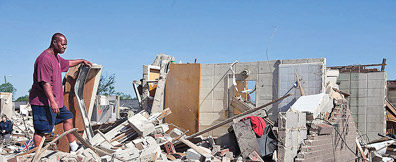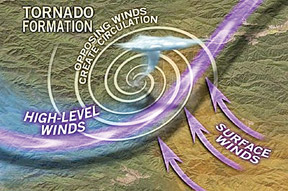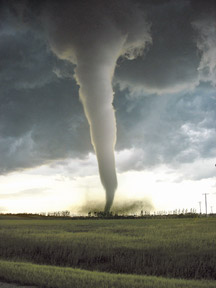|
Record breaking tornado season:
April of Peril
Sajitha Pematunge
|

Aftermath of deadly tornados in Tuscaloosa, Alabama
|
You may have watched Twister, imagine seeing the real thing coming at
you 300 kilometres per hour. It maybe a ‘once-in-a-blue-moon’ phenomenon
for Sri Lanka, but for countries like the US it is frighteningly common.
A tornado is a violently rotating column of air extending from a
thunderstorm to the ground. Most tornadoes move at speeds of 16 to 32
kilometres per hour. Some can reach up to 113 kilometres per hour.
They rarely travel more than 10 kilometres in their short lifetimes.
However the most violent tornadoes are capable of massive destruction
cutting a clear pathway 1.6 kilometres wide and 80 kilometres long in an
hour.
The April 27 - 28 tornado outbreak unleashed the power of 211
tornadoes on the Southern states of Alabama, Tennessee, Mississippi,
Georgia, Virginia and Arkansas. The death toll of the storm system that
plowed through Southern US is 350 and rising, leaving thousands of homes
and businesses destroyed, and thousands more damaged.
‘Developed’ hypocrisy
Trees stuck like sticks from the ground, completely stripped of
branches. Scenes of devastation were more commonly observed in a war
zone or after an earthquake. Authorities are working to reach those
trapped in the rubble.
In the midst of rescue operations, even in a ‘developed’ country as
the US, curfews had to be enforced to discourage looters that sought to
make the best of the situation in the mayhem that followed Wednesday’s
tornado devastation. Hundreds of people are still unaccounted for.
It is the second deadliest single day string of tornadoes since the
National Oceanic and Atmospheric Administration began keeping records.
This tornado season also holds the record for most number of tornadoes
in a single day (211).
The deadliest single day for tornadoes in the US was on March 18,
1925, with 747 fatalities across seven states. The largest previous
number of tornadoes on record in one event took place from April 3 - 4,
1974, with 148 tornadoes.
Perfect recipe
Meteorologist Heather Buchman believes that a 150 mph jet stream, an
area of maximum winds high up in the atmosphere, made last Wednesday’s
outbreak so catastrophic.
Apparently the persistent presence of this jet stream over Southern
US makes April so perilous and notorious for tornadoes, with nearly 900
reports of tornadoes April this year!
The current La Nina has caused the jet stream to dip further south,
causing sever weather anomalies – the perfect recipe for thunderstorms -
intense upward motion in the atmosphere, with the jet stream moving over
warm humid air.
To top it off winds of up to 50 mph in the lower levels of atmosphere
blew from the South, with the jet stream blowing from the West, created
a rotating environment, causing thunderstorms to spin. This is the first
phase of tornadoes.
Meteorologists claim that there was a strong low-level flow of warm
humid air from the Gulf of Mexico. The unusually warm temperatures of
the Gulf of Mexico added warm humid air, which was like fuel to the
storm system.
Tornado fact file
|

Formation of a tornado |
Tornadoes are classified as weak, strong or violent storms. Violent
tornadoes comprise only about two percent of all tornadoes, but they
cause 70 percent of all tornado deaths and may last an hour or more.
Giant, persistent thunderstorms called supercells produce the most
destructive tornadoes. People, cars, and even buildings may be hurled
aloft by tornado-force winds or simply blown away. Most injuries and
deaths are caused by flying debris. A tornado’s signature funnel is
actually transparent. They only become visible when water droplets of
the storm condense or when dust and debris are sucked in. A tornado
funnel typically grows about 200 metres wide.
‘Tornado Alley’, consisting of South Dakota, Nebraska, Kansas,
Oklahoma, northern Texas and eastern Colorado, generates the most
powerful and destructive twisters.
How tornadoes form
A tornado usually forms when changes in wind speed and direction
create a horizontal spinning inside a storm cell. This is then tipped
vertical by rising air.
Environmental clues
Tornado forecasting is not as good as hurricane warnings. Today the
average warning time for a tornado alert is 13 minutes. But some
environmental clues give away their approach: Dark, often greenish sky,
wall cloud, loud roar; similar to a freight train. US NOAA
|

It is the second deadliest single day
string of tornadoes in 86 years |
Tornado: No stranger to Sri Lanka
Tornadoes are rare in Sri Lanka, but not unheard of.
Below are a several tornado related incidents.
July 12, 2008 - a waterspout – a type of tornado was sited off the
coast of Bambalapitiya
October 14, 2008 - a tornado hit Horahena - a small village, situated
in Hokandara -
five houses in an area of eight to 10 square kilometres were damaged
November 21, 2008 - a tornado hit Thilakaudanagama of Meetiyagoda,
Galle, damaging 37 houses
July 15, 2009 - a tornado ripped through several villages on the
coast of Puttalam.
Estimated damage was Rs 40 million, 140 houses were damaged, three
people injured
August 19, 2010 - a tornado hit Ampara, Inginiyagala and Namalwala
areas. Twenty-nine houses were completely damaged, around 50 buildings
were partly damaged.
The area also experienced hail! |



